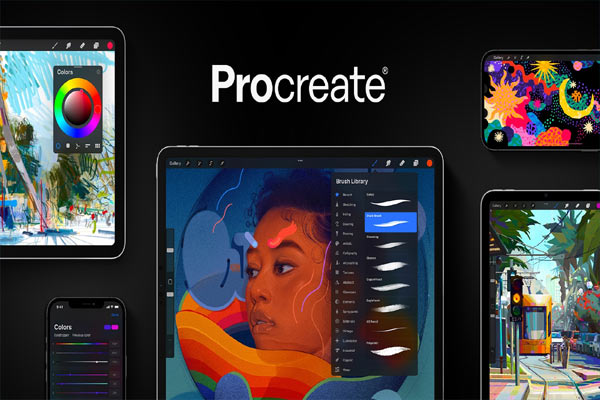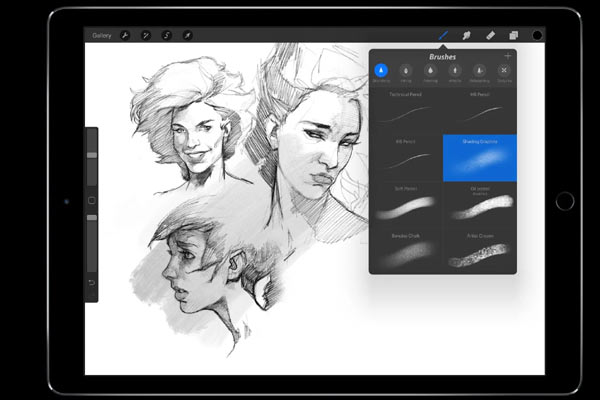
Digital Paintings with Procreate: More and more artists these days are opting to create their works in digital format. Stunning digital artworks with realistic textures and brush strokes are now simpler to make than ever before thanks to programmes like Procreate.
The digital painting community has been radically altered with the release of Procreate, a strong art programme. It offers a broad variety of brush types, textures, and other tools, allowing users to create digital paintings that are difficult to tell apart from their real-world counterparts. In this article, we will delve into Procreate’s brush and texture options to learn how to make photo-realistic digital artwork.
Creating Realistic Digital Paintings with Procreate’s Brushes and Textures : Things to keep in Mind

Selecting an Appropriate Brush
Choosing the right brush is crucial while working on a digital painting. A wide variety of useful brushes for various tasks are included in Procreate. If you want your paintings to seem like they were painted with oils, watercolours, or acrylics, then you need brushes that give the impression of using those mediums.
The brush’s texture is an essential factor to consider while making your selection. You may give your paintings more dimension and texture with the help of Procreate’s many brush textures. Rough, smooth, moist, and dry are all examples of textures.
Stacking Layers
Layers are a crucial component of digital painting, and Procreate makes it possible to work with them. The use of layers makes it possible to modify a painting independently of its previous iterations. The realism may be enhanced by playing with the opacity and blending settings of the various layers.
Setting the Scene
After establishing your layers and picking a brush, you may begin painting. You should begin with the history, as it will serve as your foundation. In order to give your painting more depth and texture, you may use various brushes and textures to create a backdrop.
Specification Extension
The next step in painting is to fill in the details, once you have finished the backdrop. The various brushes and textures are useful for this purpose. Oil paints, watercolours, and acrylics are just a few examples of classic painting mediums that may be simulated using special brushes.
Texture Use
You may give your paintings more depth and dimension with the help of Procreate’s selection of textures. There are also cloth and paper textures among them. Use these textures to give your paintings a more lifelike appearance.
Harmonising Hues
The smooth blending of colours is one of the benefits of digital painting. The blending features in Procreate allow you to mix colours together for a more natural look. Blending modes may also be used to create unique results.
Incorporating Image Sources
Last but not least, while making a photorealistic digital painting, it is crucial to utilise reference pictures. By doing so, you will be able to paint a more realistic likeness of your subject. The colours, textures, and lighting of your topic may be studied with the use of reference pictures.
Tips and Techniques for Creating Texture and Depth in Your Digital Paintings
Creating texture and depth is an essential aspect of digital painting, as it helps to bring your artwork to life. Whether you’re painting a landscape, portrait, or still life, adding texture and depth can make your painting look more realistic and engaging. In this article, we will explore some tips and techniques for creating texture and depth in your digital paintings.
Use a variety of brushes
Using a variety of brushes can help you create texture and depth in your digital paintings. Different brushes have different textures and can be used to create different effects. For example, using a rough brush can create a textured look, while a smooth brush can create a polished look. Experiment with different brushes and see what works best for your painting.
Adjust brush opacity and flow
Adjusting the opacity and flow of your brush can help you create different levels of texture and depth in your digital paintings. Opacity refers to how opaque or transparent your brush strokes are, while flow refers to how much paint is released as you paint. Using low opacity and flow can create a subtle, layered effect, while using high opacity and flow can create bold, solid strokes.
Use layers
Using layers is a great way to create texture and depth in your digital paintings. By creating multiple layers and painting on each layer, you can create a sense of depth and dimensionality. For example, you can create a layer for the background, a layer for the mid-ground, and a layer for the foreground. You can also adjust the opacity and blending modes of each layer to create a more realistic effect.
Add texture with patterns and textures
Adding patterns and textures is another great way to create texture and depth in your digital paintings. You can use patterns and textures to create a variety of effects, from subtle texture to bold, graphic designs. You can create your own patterns and textures, or use pre-made ones that come with your digital painting software.
Use light and shadow
Using light and shadow is a fundamental technique for creating depth and dimensionality in your digital paintings. By understanding how light and shadow interact with objects, you can create a sense of depth and form. For example, by creating highlights and shadows on a person’s face, you can create a sense of form and dimensionality.
Experiment with different blending modes
Experimenting with different blending modes can help you create unique effects in your digital paintings. Blending modes allow you to blend layers and colors in different ways, creating interesting and unexpected results. For example, using the overlay blending mode can create a vibrant, colorful effect, while using the multiply blending mode can create a darker, more subdued effect.
Use reference images
Using reference images is a great way to create texture and depth in your digital paintings. Reference images can provide you with information about how different materials look and feel, such as wood, metal, and fabric. By studying reference images, you can create a more accurate representation of these materials in your digital paintings.
Create a sense of movement
Creating a sense of movement is another way to add depth and dimensionality to your digital paintings. By creating lines and brush strokes that flow in a particular direction, you can create a sense of movement and energy in your painting. For example, using diagonal brush strokes can create a sense of motion and directionality.
Conclusion
In conclusion, using Procreate to create a photorealistic digital painting is a fascinating and satisfying endeavour. The correct brushes, textures, and techniques may make digital paintings seem virtually identical to their conventional counterparts. Beautiful digital paintings, worthy of admiration, may be the result of practise and experimentation.
Procreate for Mac Blogs